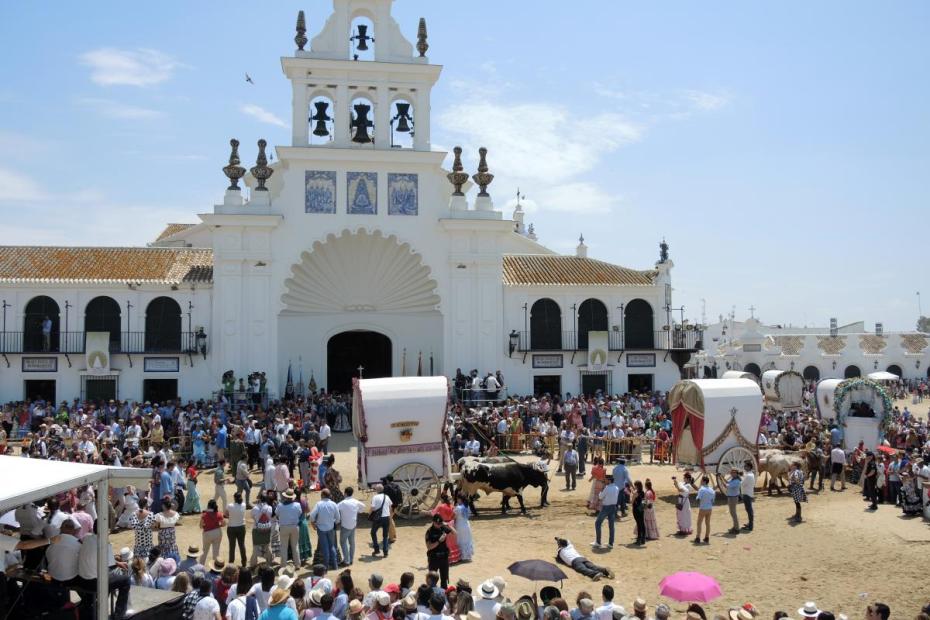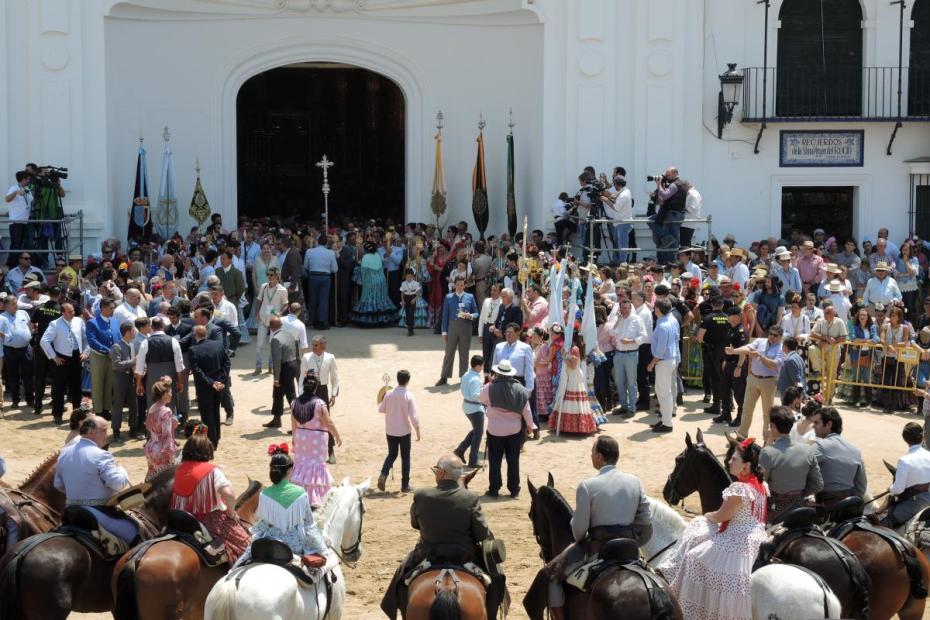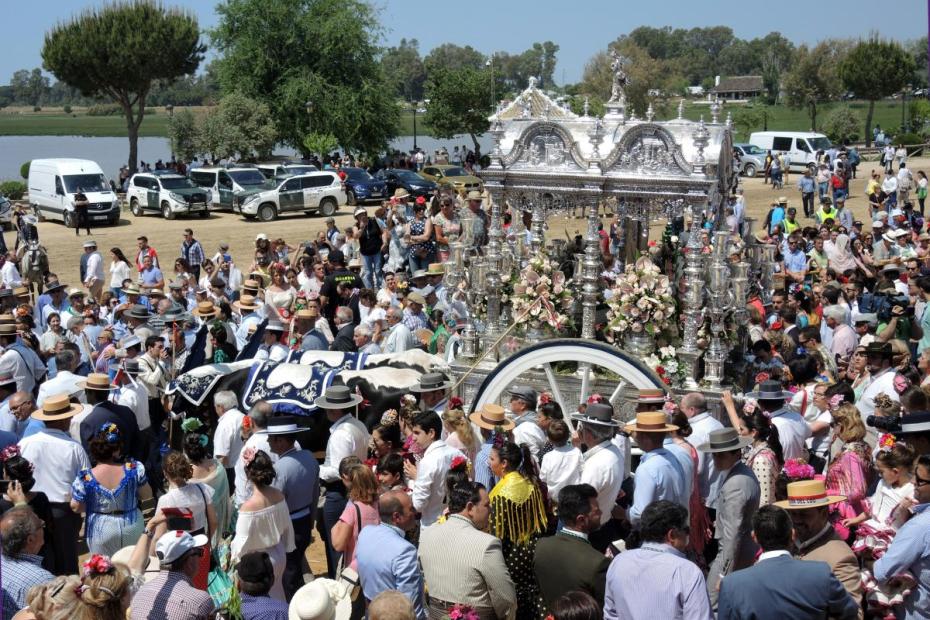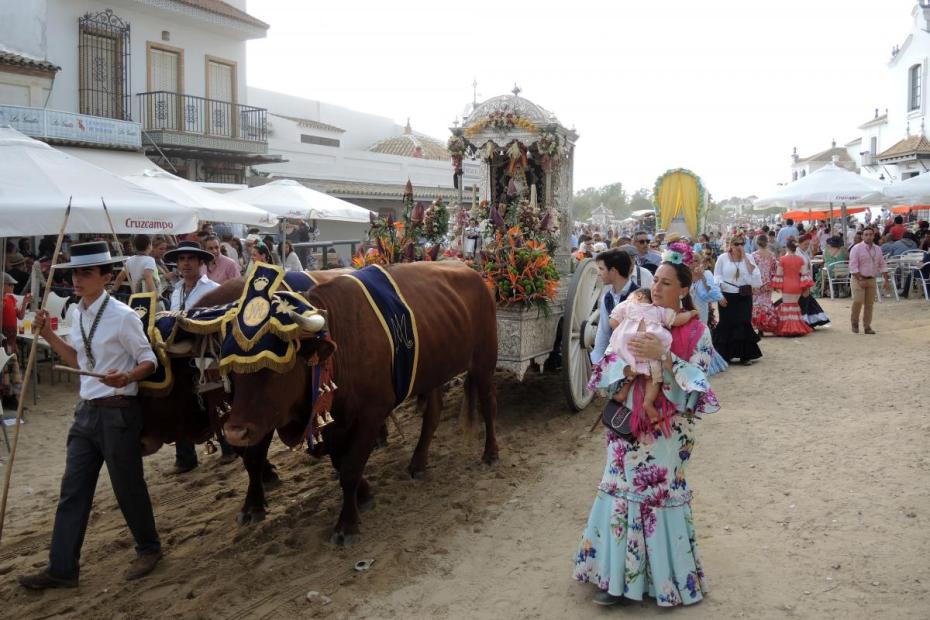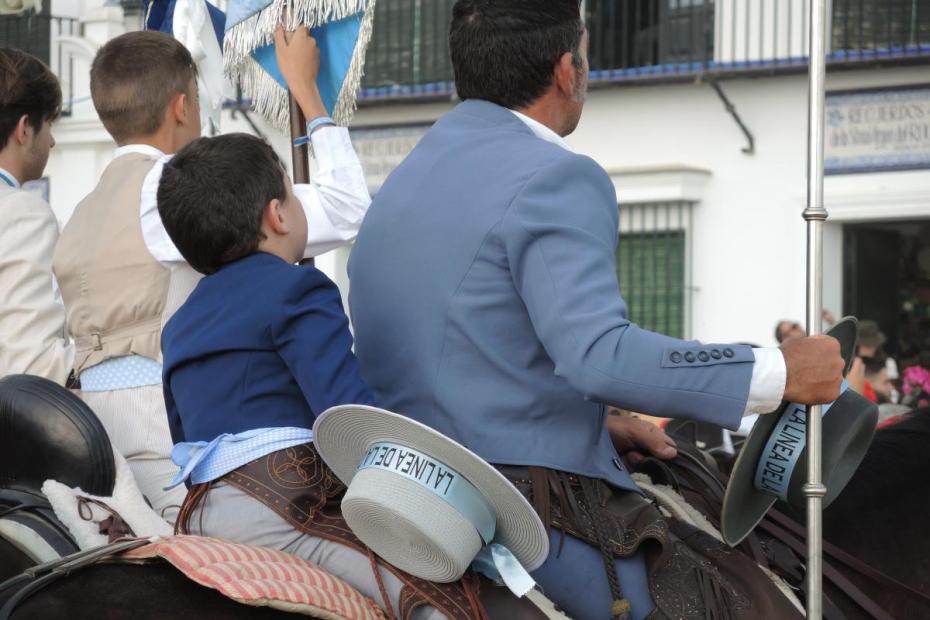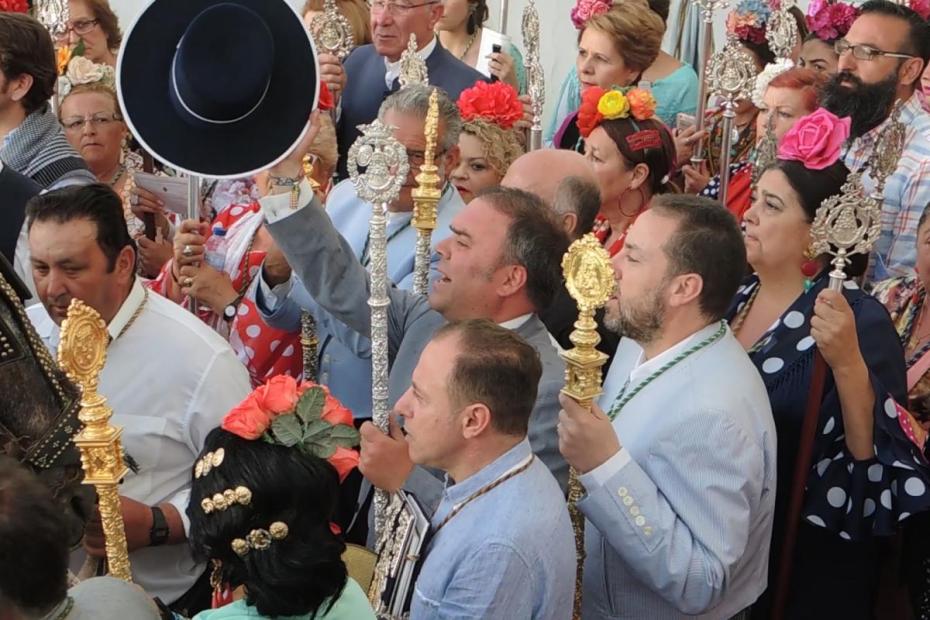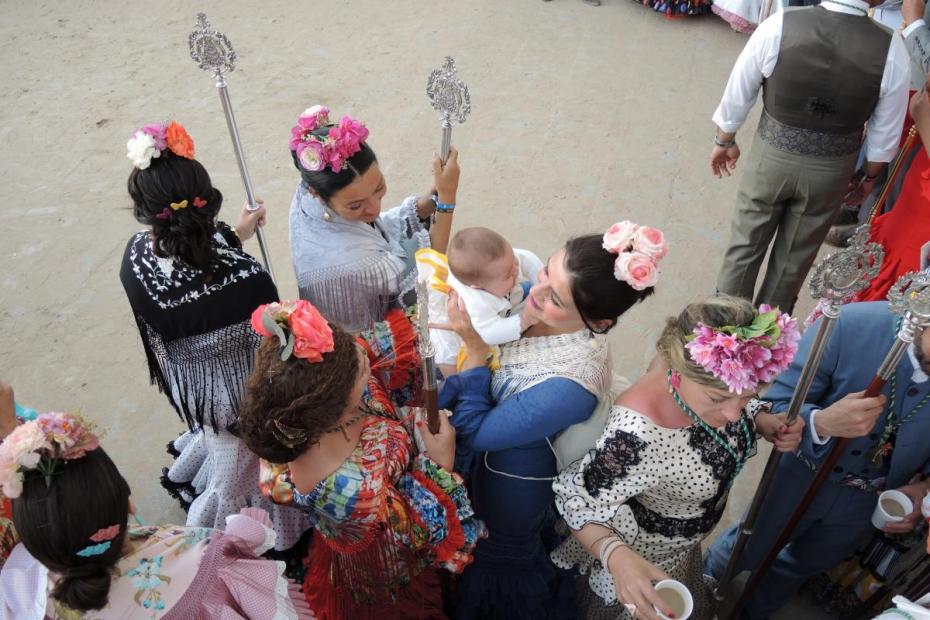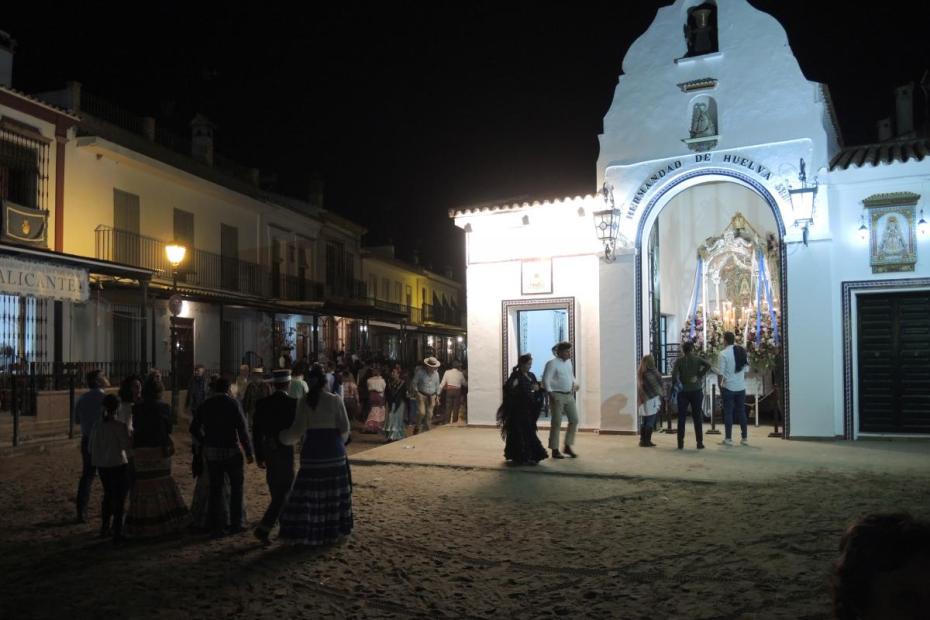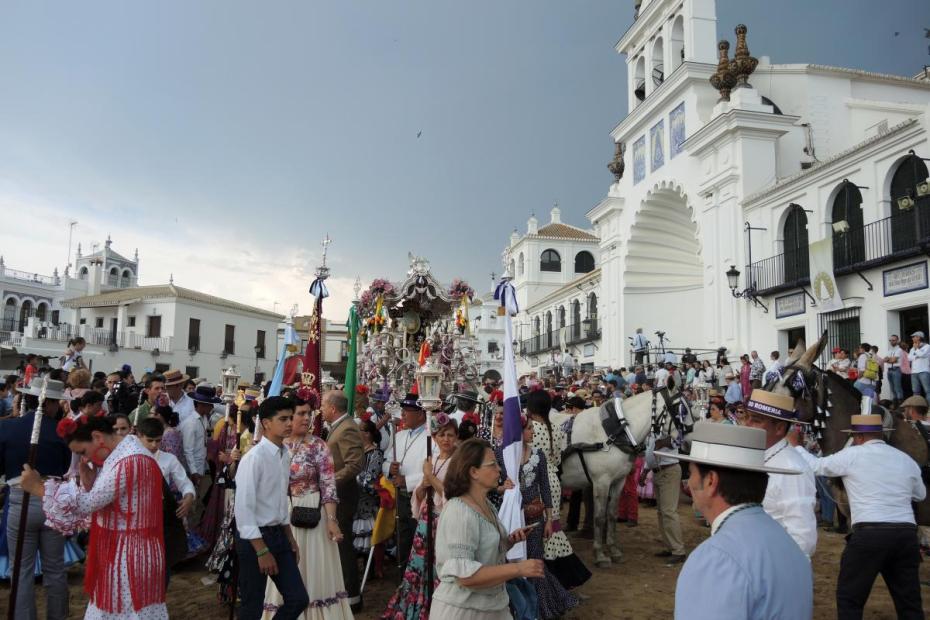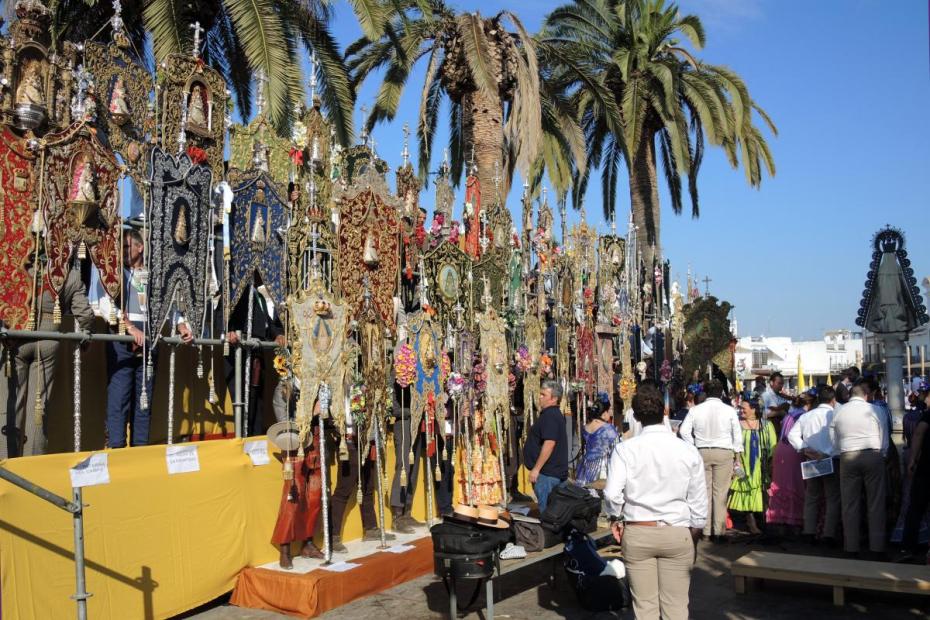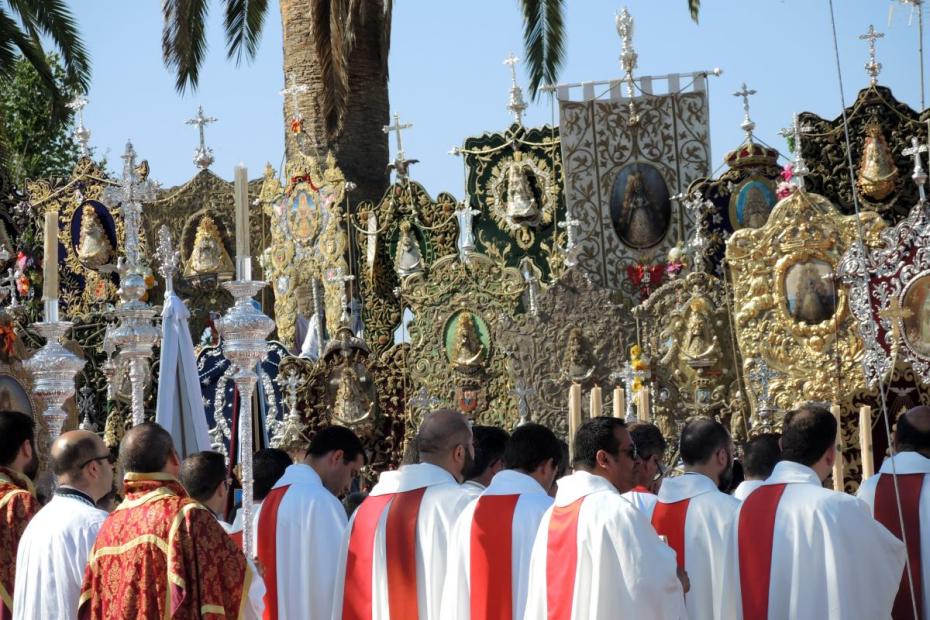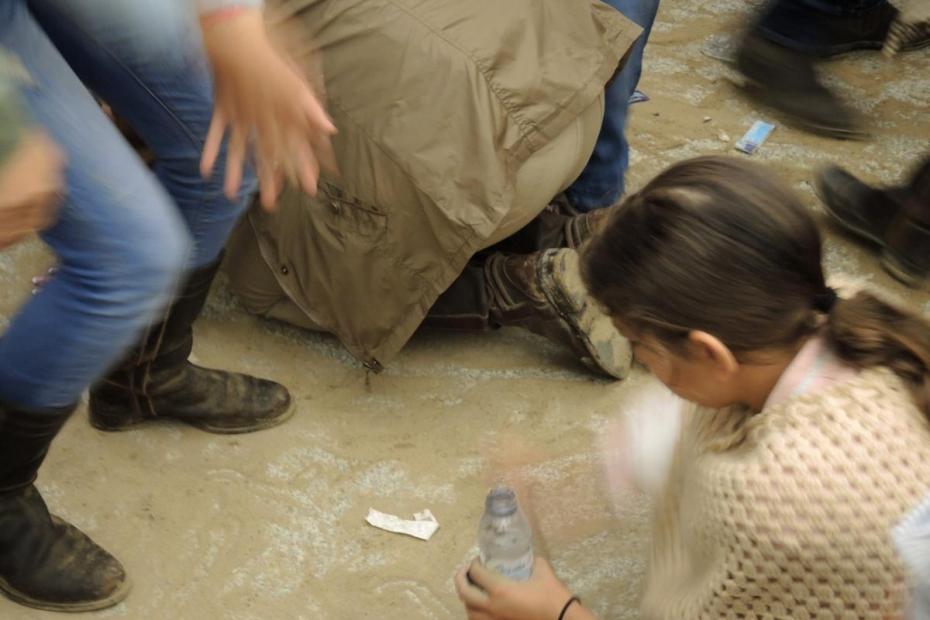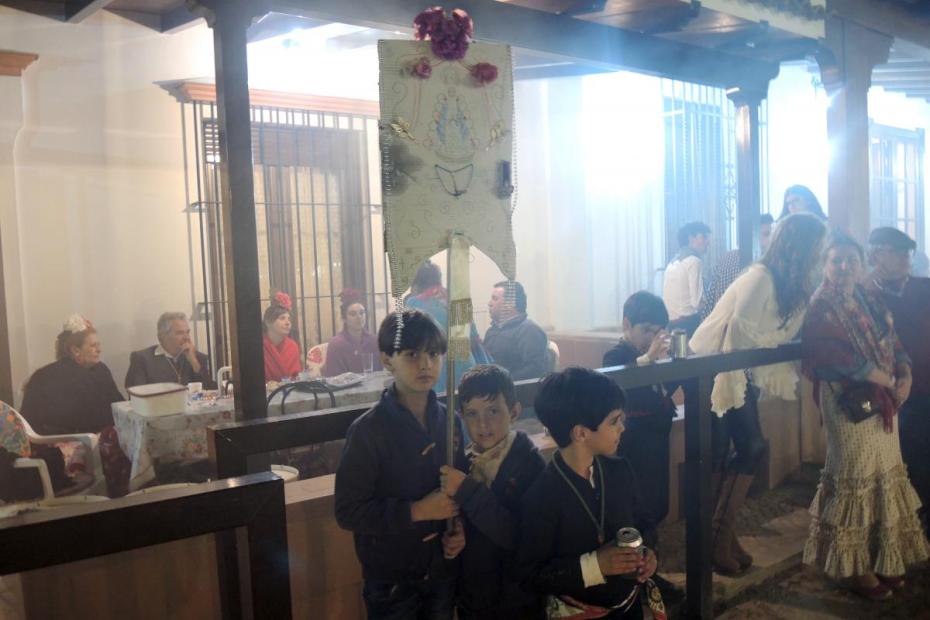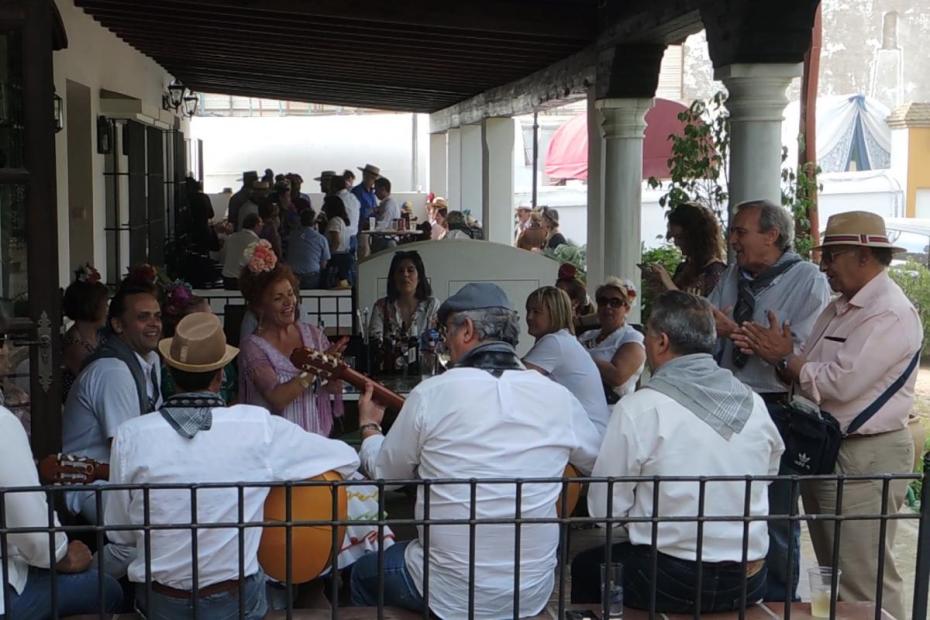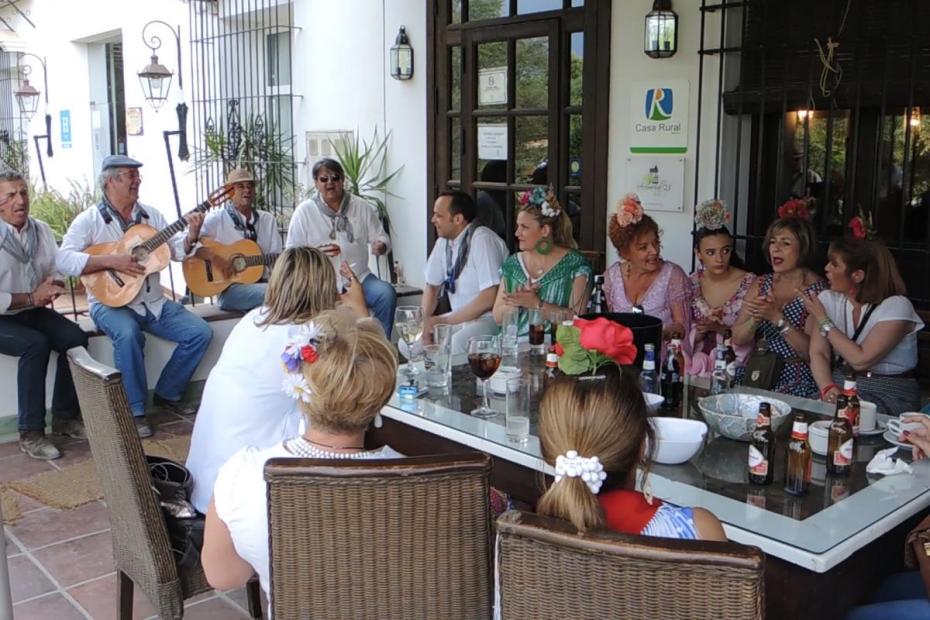Early in the week before Pentecost, the sleepy town of El Rocío starts to come to life, and cars and trucks arrive to open and prepare the houses for an onslaught of visitors. On Wednesday evening, the Hermandad Matriz, the brotherhood that started and organizes this devotion, is the first to make its way into town, led by a corps of flutes and drums.
Thursday
On Thursday, the covered wagons of more than 121 other “filial” brotherhoods whose presence is integral to the feast begin to arrive into town, in planned order, on four long wagon trails that exist for this purpose. For the brotherhoods, as at many pilgrimages, the journey is at least as important as the destination, but people consistently seem joyful to have reached El Rocío. The town is soon closed to almost all vehicles, and horses and pedestrians take over the sandy streets. Bells peel and simple fireworks are shot off intermittently from different quarters of town to announce the arrival of each brotherhood’s elaborate simpecado carriage to its house. The arrivals take days, but as they continue, the town takes on added energy.
The doors of the church are open for anyone who wants to come visit the image of Nuestra Señora del Rocío, and in the streets and houses people greet one another and enjoy each other’s company. From a programmatic point of view, the first official order of business for the brotherhoods is their reception at the front doors of the ermita (hermitage), the whitewashed sanctuary church.
Friday
On Friday evening, beginning in reverse order of antiquity, the 40 oldest filial brotherhoods make their way to those doors for their reception. The leaders of the Hermandad Matriz stand at the door in formal flamenco and corto dress to receive the 40 brotherhoods one group at a time. Drummers and horses often lead the way, followed by brotherhood members on foot, then by the ox- or mule-drawn carreta de simpecado, the elaborate carriage that carries the brotherhood’s simpecado, its embroidered standard with an image of Our Lady of Rocío at the center. After the brotherhood’s leaders are greeted and embraced by the leaders of the Hermandad Matriz, the animals pulling the carreta de simpecado are directed to pull the carreta right up to the doors of the church. That act interjects a certain sense of danger: the oxen sometimes come up with such force that the Hermandad Matriz has to step back to avoid getting trampled. After this, the group offers some signs of devotion, perhaps chanting briefly to the image of Our Lady of El Rocío above the altar, or showing some other sign of enthusiasm, and eventually moves on to make way for the next group. The brotherhoods do not, as groups, go into the church for their reception, though during this time many individuals have been making their way inside from the side doors to visit Our Lady of El Rocío.
While this continues in front of the sanctuary, in the the houses, streets and plazas, life in El Rocío takes on its own rhythm. Day and night from now on, on front porches, in interior patios, and in yards, people sit and converse over wine and food. Small groups sit for hours singing energetic sevillanas rocianas, a regional style of guitar song related to flamenco music, with lyrics particular to the feast. The songs speak of the experience of the pilgrimage, and often contain some note of devotion to Our Lady of El Rocío or a romantic story, such as about a couple who fell in love on the pilgrimage. One man described the sevillanas as “a prayer done by two people. It becomes a prayer multiplied by 20 voices. Then you are singing verses to the Madonna and sharing a moment with your friends with a glass of wine. There is nothing bad about this. In the romeria [the pilgrimage] there is time for everything. Time for a little fun, to be with the Virgin, time to go to the services… a way of life.” Scenes like this are a constant for the next several days.
Saturday
On Saturday, the town begins to feel much more crowded. Following late morning Mass, the leadership and many members of the Hermandad Matriz line up at the door of the sanctuary, in flamenco and corto dress, holding the staffs that signal their membership in the brotherhood’s governing board, to begin receiving the 80 more brotherhoods that have yet to present themselves at the sanctuary.1 They stand in the sun greeting each group’s leadership, the same way as the night before, as some of the largest brotherhoods make their entrances. One by one, all day long, the brotherhoods enter the plaza in front of the open doors of the sanctuary. Horsemen and women often line up at the edge. Riders and those on foot bless themselves before the image of the Virgin, who they can see through the doors, in front of the altar. Ox-drawn simpecado carriages pull right up to the door. Sometimes the brotherhood members acclaim, as will be acclaimed repeatedly over the next two days,
¡Viva la Virgen del Rocío!
¡Viva la Divina Pastora! (the Divine Shepherdess [Mary])
¡Viva la Reina de las Marismas! (the Queen of the Marshes)
¡Viva la Patrona de Almonte! (the Patroness of Almonte)
¡Viva la Blanca Paloma! (the White Dove)
¡Viva los Pelegrinos! (the pilgrims)
¡Viva el Pastorcito Divino! (the Little Divine Pastor [the baby Jesus she holds])
¡Viva la Madre de Dios! (the Mother of God)
The greetings and processions seem to go on forever.
On the way to and from the ermita for their reception, carretas de simpecado stop at other prearranged brotherhood houses to pay their respects. The gates to the alcove with the house’s carreta are opened, and the oxen are pulled up so that the simpecados and their carriages come face to face. The group sings a Salve Regina or some other song, and the members greet each other with kisses.
Inside the sanctuary, guards for the Hermandad Matriz watch over the crowds, vigilant to ensure sure that men never enter the sanctuary with a hat on, and that nobody is talking on a mobile phone. People stand in front of the image of El Rocío, occasionally crying a bit, and then often pose for pictures in front of her. Interviewees stressed their love for her, and many described the memories that the visit stirs up for them. One man said, for example, that when he arrived there he was especially conscious of his father, who had died three years ago. The father had a great devotion to El Rocío and asked that his family not lose that. Many others said that they were fulfilling a promesa, or vow, that they had made to her.
Throughout the town, women walk in flamenco-style dresses, and men and women ride horses—the men often wearing elegant outfits as well, particularly if they are riding horses. The women’s dresses are dramatically colorful, form-fitting, often ruffled. Some women wear fringed shawls. Most tie up their hair in some fashion, and wear flowers in their hair bun. The men’s style is deliberately Andalucian as well, an outfit known as a traje corto: broad brimmed, flat hats perched very precisely; form-fitting campero jackets; long waisted tight pants and riding boots. Though the fashions seem anachronistic, women said that there are new styles and variations in the flamenco dresses every year, and they strive to keep up with the fashions, bringing multiple dresses to last the week. The costumes have come to be associated with Andalucian identity.2 Women said that they didn’t perceive the costumes as a religiously significant. They wear them simply because they enjoy it. “It gives a flavor of joy,” one said. Men almost always wear a traje corto if they are riding. Not everyone wears a costume—many simply wear street clothes along with their brotherhood medals if they belong to a confraternity.
Many people just walk around the streets, taking the sights in, or sit on the patios or in the courtyards at their hermandades, enjoying the company of friends and family, snacking, and taking in the ambiance of the place.
Rocieros don’t easily separate “religious” and “secular” parts of the feast. That’s part of the point. The way these are all mixed up is what is most important. Even the specific locations—sanctuary vs. home—do not easily define what is religious or not. The whole town, after all, is Her town, named El Rocío after Her.
Outside of town, huge fields have filled with cars for day visitors, or tends, and carriages of brotherhoods. All of this takes massive coordination of police, fire and ambulance services brought into town. There is even a free veterinary service for the huge number of horses in town.
Celebrations in houses continue deep into the night, and at midnight, a Rosary procession winds through town. Most watch it respectfully from their houses when it passes.
Pentecost Sunday
Sunday morning the plaza next to the sanctuary, the largest plaza in town, is the site of a large Pontifical Mass, celebrated by the Cardinal Archbishop of Madrid, to mark Pentecost Sunday. The altar is festooned with the elaborate simpecados, or banners, of all the accredited brotherhoods. In front of the altar, seating is reserved for brotherhood leaders, who make a reaffirmation of faith at the end of the Mass. The Mass is a major event, but ultimately accommodates only a very small portion of the population in town for the feast (the Hermandad Matriz suggested it was about 5,000 people). Still, it is broadcast over loudspeakers around town, and played on televisions in many houses. Except for an evening Mass for the drummers and cart-drivers in the brotherhoods, it is the only Mass of the day.
Even on a feast as important in the Catholic world as Pentecost, it is hard to deflect attention from Our Lady of El Rocío. Even the songs at the Mass reference her. One of the titles given to Our Lady of El Rocío in the many Vivas of that day and the surrounding days, ¡Viva la Blanca Paloma!—Long Live the White Dove!—ascribes to Mary the visual image customarily used to picture the Holy Spirit. On the day that marks the descent of the Holy Spirit, this seems especially surprising.3
The bulk of the day is given to ordinary encounters, songs, etc. in the brotherhood houses, though a steady stream of people stop by the ermita to visit the image of Our Lady of El Rocío. One man proposed marriage to a woman in front of the Virgin.
Devotion turns to frenzy, in the church and in the streets
For many rocieros, the time when the Virgin comes out of the church and into the streets is the most important time of the feast, and the buildup to that takes hours. By late night, anticipation is palpable as people await the culmination of the feast. In the Plaza Doñana, the town’s largest square, the brotherhoods line up for a Rosary, led by the Hermandad Matriz. In reverse order of seniority, a delegation from each brotherhood in the Plaza Doñana leaves to process past the front doors of the sanctuary with its simpecado. Lest anyone should miss the procession coming by, every bell in the square at each hermandad house rang. Fireworks bang in the air. The drummers and flutists play, and the brotherhood processants are in full dress. The squares outside the church fill, and along the Rosary route people stand in front of their houses to watch, sometimes holding flares.
Well before midnight, the sanctuary of El Rocío itself is already packed to capacity. Near the altar, young men from the host town of Almonte jostle impatiently around the tall, semicircular iron gate that separates the Virgin’s palio from the people. Members of the Hermandad Matriz, all people from Almonte, zealously guard the right to carry the palio on their shoulders, and these young men ensure that they are the first of the Almonteños to reach the palio, to touch it and to carry it. There are brawny guards in black shirts to keep order, and twice, like bar bouncers, they physically expel men from the church. The church is hot from the crowds and buzzing with an anxious energy as the guards push the crowds to the sides to ensure that the central aisle is clear. This preserves the view of the palio and the Virgin of El Rocío for each of the brotherhoods whose officials pass by the front of the church, paying honor to her through the open front doors. It also ensures that the Hermandad Matriz leaders will eventually be able to get in, and the palio that carries the Virgin would be able to get out. For some two hours young men push their way to the tall gate, sometimes trying to climb it, but being held back by their peers.
At about 1:45 a.m., the Almonteños finally storm over the gate, many tumbling to the floor, to be the first to reach the palio to carry the Virgin. They compete not only to prevent outsiders from doing so, but for the honor themselves. A young man and a young woman climb up on the palio to wrap bows around two of the silver poles. (Almonteños there reported that the woman who did so was given the privilege of doing it in memory of her husband who had “died of a heart attack 10 days ago: 41 years old” and would otherwise have been there to carry the palio himself). Men scramble to get a place under the palio, so as to carry it, and the energy remains exceptionally high as people wait for the last of the hermandades to pass. The image cannot leave until the simpecado of the Hermandad Matriz arrives.
Just before 2 a.m., the Hermandad Matriz, the last in the procession of hermandades, makes its way to the doors, and its officers run in with their simpecado to the now-opened gates of the sanctuary. A line of men on each side struggle to hold back the crowd in the sanctuary so the palio can pass. The palio carrying the Virgin sways and tilts precariously as it moves forward from the altar, while men push to get close to her and other men push to clear the way.
Outside the plazas are tightly packed with people, and they too reach a sort of frenzy when the Virgin exits the church. That frenzy does not ever seem to diminish. The contrast between this and the precise way the costaleros carry the palios at Seville’s Semana Santa is remarkable. This palio bobs and weaves, and tilts at an angle. The median age in the plazas and the streets drops markedly that night, making it look like a huge gathering of 20-somethings. It is a perilous place for those who are not quick on their feet. The flow of people is so strong and so fitful that anyone not sure-footed would be in danger of being knocked over when the palio suddenly changes direction, as often happens.
For the next 10 hours, the image of the Virgin is brought to visit the houses of the brotherhoods. The path looks more chaotic than planned, though there is a plan. At the home of each brotherhood, members greet her in cheers: ¡Viva la Virgen del Rocío! ¡Viva! ¡Viva la Blanca Paloma! ¡Viva! ¡Viva la Reina de las Marismas! ¡Viva! ¡Viva la Reina de Andalucía y Viva la Madre del Dios! (Long Live the Virgin of El Rocío!… the White Dove!... the Queen of the Marshes!... the Queen of Andalucia, and... the Mother of God!). In cases where the brotherhood does not yet have an official house, some place is set aside for the palio to be carried to their simpecado.
The procession amounts to “a body-to-body struggle” to demonstrate closeness to the Virgin, and to claim the rights of the Almonteños to carry her. It is even a struggle, in a masculine way, over “whose” she is.4 Rarely is anyone not from Almonte given permission to carry the palio. In 2011, the struggle was so fierce that the palio carrying the Virgin was damaged. The struggle has moderated since, and interviewees from other brotherhoods say that they respect the right of the Almonteños to carry the palio, though there are always young men who make a promise to the Virgin to do so. But the fervor and flow of people around the palio still seem remarkable. Almonteños take turns carrying and guarding access to the palio all night and morning.
Rocieros don’t speak of “her image” or “her statue,” but simply about “Her” or “She.” After she leaves the church, one woman marvels, “look at Her flying above the crowd.”
At about 11 a.m. Monday, the image is finally returned to the sanctuary, after which things quiet down considerably. The sanctuary is thick with sand tracked in by so many visitors, and a few people even collect some of it to take home in bottles. Attention in town exhaustedly turns to preparation for departure, which again takes days for the wagon trains to complete. Though the atmosphere is a bit more subdued, people manage to enjoy themselves together, as always, until their time for departure arrives. They still have the trail ride home to look forward to.
- 1In 2018, the year observed and described here, there were 121 filial brotherhoods. That number continues to grow.
- 2Michael D. Murphy explores the historic elitist designation of these costumes, and the way that the choice to wear them today alternately helps reinforce and obliterate the social boundaries between pilgrims. The costumes are both historic markers of elite class status, and now also of regional identity. “Both the wearer of the costume and the observers of it are perfectly free to emphasize whichever of its social referents—class or region—they choose.” Michael D. Murphy, “Class, Community and Costume,” Anthropological Quarterly 67 no. 2 (April 1994): 54.
- 3The president of the Hermandad Matriz links the name of Nuestra Señora del Rocío, Our Lady of the Dew, to the post communion prayer from the Latin Pentecost liturgy, “May your Holy Spirit, Lord, descend upon us, purify our hearts and, with the soft dew of your coming, make them fruitful.” Juan Ignacio Reales Espina, El Rocío: Una Realidad de Fe (Sevilla: Sermendad Matriz Ntra. Sra del Rocío de Almonte/Padilla Libros Editores y Libreros, 2018), 9.
- 4Rosa María Martínez Moreno, “La romería del Rocío en Andalucía, una fiesta de la posmodernidad” Gazeta de Antropología 13, artículo 05 (1997). http://hdl.handle.net/10481/13566.
